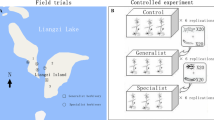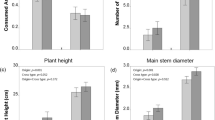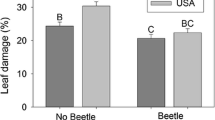Abstract
The local invasion success of invasive plants can be strongly influenced by reduced antagonist pressure and changes in resistance-mediating traits, but information about comprehensive metabolic backgrounds of native versus invasive populations and their functions is lacking. We examined the defence potential of ten native (Chinese) and ten invasive (European) populations of the shrub Buddleja davidii (Scrophulariaceae) grown in a common garden in the invasive range. We compared the chemical defence arsenal of these plant populations, scored their herbivore damage in the field and determined effects on a generalist herbivore species in the laboratory. Moreover, we isolated compounds that mediate resistance against two potential generalist herbivore species and a pathogenic fungus using bioassay-guided fractionation. Metabolic fingerprinting revealed that invasive populations were chemically very similar to one native population (Mupingzhen, Sichuan Province), which may indicate the geographic region from where the species was introduced. Herbivore damage and herbivore performance were reduced on plants of invasive populations. Different chemical compounds provided distinct resistance against the herbivore and fungus species. Based on our results we suggest that the diverse cocktail of chemical compounds, potentially together with physical leaf features, may provide this plant species with an effective defence arsenal against antagonists. In particular, advantageous pre-adaptations and/or shifted profiles of the chemical bouquet may contribute to the success of invasive plants.




Similar content being viewed by others
References
Alalouni U, Schädler M, Brandl R (2013) Natural enemies and environmental factors affecting the population dynamics of the gypsy moth. J Appl Entomol 137:721–738
Barbosa P, Krischik VA (1987) Influence of alkaloids on feeding preference of Eastern deciduous forest trees by the gypsy moth Lymantria dispar. Am Nat 130:53–69
Barbosa P, Gross P, Provan GJ, Pacheco DY, Stermitz FR (1990) Allelochemicals in foliage of unfavored tree hosts of the gypsy moth, Lymantria dispar L. 1. Alkaloids and other components of Liriodendron tulipifera L. (Magnoliaceae), Acer rubrum L. (Aceraceae), and Cornus florida L. (Cornaceae). J Chem Ecol 16:1719–1730
Barton KE, Koricheva J (2010) The ontogeny of plant defense and herbivory: characterizing general patterns using meta-analysis. Am Nat 175:481–493
Bennett AE (2013) Can plant–microbe–insect interactions enhance or inhibit the spread of invasive species? Funct Ecol 27:661–671
Bowers MD (1991) Iridoid glycosides. In: Rosenthal GA, Berenbaum MR (eds) Herbivores. Their interactions with plant metabolites: chemical participants, 2nd edn, vol 1. Academic Press, Inc. Harcourt Brace Jovanovich, Publishers, San Diego, pp 297–325
Broz AK, Broeckling CD, De-La-Peña C, Lewis MR, Greene E, Callaway RM, Sumner LW, Vivanco JM (2010) Plant neighbor identity influences plant biochemistry and physiology related to defense. BMC Plant Biol 10:115
Callaway RM, Ridenour WM (2004) Novel weapons: invasive success and the evolution of increased competitive ability. Front Ecol Environ 2:436–443
Casanova E, García-Mina JM, Calvo MI (2008) Antioxidant and antifungal activity of Verbena officinalis L. leaves. Plant Foods Hum Nutr 63:93–97
Cassey P, Garzía-Díaz P, Lockwood JL, Blackburn TM (2018) Invasion biology: searching for predictions and prevention and avoiding lost causes. In: Jeschke JM, Heger T (eds) Invasion biology: hypotheses and evidence. CAB International, Wallingford, pp 3–13
Chen G, Sun WB, Sun H (2010) Leaf epidermal characteristics of Asiatic Buddleja L. under scanning electron microscope: insights into chromosomal and taxonomic significance. Flora 205:777–785
Cheriet T, Mancini I, Seghiri R, Benayache F, Benayache S (2015) Chemical constituents and biological activities of the genus Linaria (Scrophulariaceae). Nat Prod Res 29:1589–1613
Doorduin LJ, Vrieling K (2011) A review of the phytochemical support for the shifting defence hypothesis. Phytochem Rev 10:99–106
Ebeling SK, Hensen I, Auge H (2008) The invasive shrub Buddleja davidii performs better in its introduced range. Divers Distributions 14:225–233
Enge S, Nylund GM, Harder T, Pavia H (2012) An exotic chemical weapon explains low herbivore damage in an invasive alga. Ecology 93:2736–2745
Farr D, Rossmann A (2014) Fungal databases. Systematic Mycology and Microbiology Laboratory, ARS, USDA, Retrieved 15 Apr 2014 from http://nt.ars-grin.gov/fungaldatabases/
Felton GW, Donato K, Delvecchio RJ, Duffey SS (1989) Activation of plant foliar oxidases by insect feeding reduced nutritive quality of foliage for Noctuid herbivores. J Chem Ecol 15:2667–2694
Fiehn O (2002) Metabolomics—the link between genotypes and phenotypes. Plant Mol Biol 48:155–171
Gatto MA, Sanzani SM, Tardia P, Linsalata V, Pieralice M, Sergio L, Di Venere D (2013) Antifungal activity of total and fractionated phenolic extracts from two wild edible herbs. Nat Sci 5:895–902
Hadacek F, Greger H (2000) Testing of antifungal natural products: methodologies, comparability of results and assay choice. Phytochem Anal 11:137–147
Hendricks LG, Mossop HE, Kicklighter CE (2011) Palatability and chemical defense of Phragmites australis to the Marsh Periwinkle snail Littoraria irrorata. J Chem Ecol 37:838–845
Houghton PJ (1985) Lignans and neolignans from Buddleja davidii. Phytochemistry 24:819–826
Houghton PJ, Mensah AY, Lessa N, Hong LY (2003) Terpenoids in Buddleja: relevance to chemosystematics, chemical ecology and biological activity. Phytochemistry 64:385–393
Jensen SR (2000) Chemistry of Buddlejaceae. Flora Neotrop Monogr 81:42–61
Jensen SR, Franzyk H, Wallander E (2002) Chemotaxonomy of the Oleaceae: iridoids as taxonomic markers. Phytochemistry 60:213–231
Keane RM, Crawley MJ (2002) Exotic plant invasions and the enemy release hypothesis. Trends Ecol Evol 17:164–170
Krischik VA, Goth RW, Barbosa P (1991) Generalized plant defense—effects on multiple species. Oecologia 85:562–571
Kriticos DJ, Watt MS, Potter KJB, Manning LK, Alexander NS, Tallent-Halsell N (2011) Managing invasive weeds under climate change: considering the current and potential future distribution of Buddleja davidii. Weed Res 51:85–96
Kuhlisch C, Pohnert G (2015) Metabolomics in chemical ecology. Nat Prod Rep 32:937–955
Kuhlmann F, Müller C (2011) Impact of ultraviolet radiation on interactions between plants and herbivorous insects: a chemo-ecological perspective. Progr Bot 72:305–347
Kühnle A, Müller C (2009) Differing acceptance of familiar and unfamiliar plant species by an oligophagous beetle. Entomol Exp Appl 131:189–199
Lamarque LJ, Delzon S, Lortie CJ (2011) Tree invasions: a comparative test of the dominant hypotheses and functional traits. Biol Invasions 13:1969–1989
Macel M, van Dam NM, Keurentjes JJB (2010) Metabolomics: the chemistry between ecology and genetics. Mol Ecol Res 10:583–593
Marak HB, Biere A, van Damme JMM (2002) Two herbivore-deterrent iridoid glycosides reduce the in vitro growth of a specialist but not of a generalist pathogenic fungus of Plantago lanceolata L. Chemoecology 12:185–192
Mitchell CE, Power AG (2003) Release of invasive plants from fungal and viral pathogens. Nature 421:625–627
Müller C (2018) Evolution of increased competitive ability and shifting defence hypotheses. In: Jeschke JM, Heger T (eds) Invasion biology: hypotheses and evidence. CAB International, Wallingford, pp 103–123
Müller-Schärer H, Schaffner U, Steinger T (2004) Evolution in invasive plants: implications for biological control. Trends Ecol Evol 19:417–422
Nylund GM, Weinberger F, Rempt M, Pohnert G (2011) Metabolomic assessment of induced and activated chemical defence in the invasive red alga Gracilaria vermiculophylla. PLoS ONE 6:e29359
Orians CM, Ward D (2010) Evolution of plant defenses in nonindigenous environments. Annu Rev Entomol 55:439–459
Pankoke H, Gehring R, Müller C (2015a) Impact of the dual defence system of Plantago lanceolata (Plantaginaceae) on performance, nutrient utilisation and feeding choice behaviour of Amata mogadorensis larvae (Lepidoptera, Erebidae). J Insect Physiol 82:99–108
Pankoke H, Höpfner I, Matuszak A, Beyschlag W, Müller C (2015b) The effects of mineral nitrogen limitation, competition, arbuscular mycorrhiza, and their respective interactions, on morphological and chemical plant traits of Plantago lanceolata. Phytochemistry 118:149–161
Patti GJ, Tautenhahn R, Siuzdak G (2012) Meta-analysis of untargeted metabolomic data from multiple profiling experiments. Nat Protoc 7:508–516
R Developmental Core Team (2014) R: a language and environment for statistical computing, vol. 3.0.3. R Foundation for Statistical Computing, Vienna
Schweiger R, Baier MC, Persicke M, Müller C (2014) High specificity in plant metabolic responses to arbuscular mycorrhiza. Nat Commun 5:3886
Tallent-Halsell NG, Watt MS (2009) The invasive Buddleja davidii (butterfly bush). Bot Rev 75:292–325
Taskova RM, Gotfredsen CH, Jensen SR (2006) Chemotaxonomy of Veroniceae and its allies in the Plantaginaceae. Phytochemistry 67:286–301
Tewes LJ, Müller C (2018) Syndromes in suites of correlated traits suggest multiple mechanisms facilitating invasion in a plant range-expander. NeoBiota 37:1–22
Tewes LJ, Michling F, Koch MA, Müller C (2018) Intracontinental plant invader shows matching genetic and chemical profiles and might benefit from high defence variation within populations. J Ecol 106:714–726
van Kleunen M, Fischer M (2009) Release from foliar and floral fungal pathogen species does not explain the geographic spread of naturalized North American plants in Europe. J Ecol 97:385–392
Verhoeven KJF, Biere A, Harvey JA, van der Putten WH (2009) Plant invaders and their novel natural enemies: who is naïve? Ecol Lett 12:107–117
Waldbauer GP (1968) The consumption and utilization of food by insects. Adv Insect Phys 5:229–288
Williamson B, Tudzynsk B, Tudzynski P, van Kan JAL (2007) Botrytis cinerea: the cause of grey mould disease. Mol Plant Pathol 8:561–580
Wink M, Schneider D (1990) Fate of plant-derived secondary metabolites in three moth species (Syntomis mogadorensis, Syntomeida epilais, and Creatonotos transiens). J Comp Phys B Biochem Syst Environ Phys 160:389–400
Wolfe LM, Elzinga JA, Biere A (2004) Increased susceptibility to enemies following introduction in the invasive plant Silene latifolia. Ecol Lett 7:813–820
Acknowledgements
We thank Dörte Goertz (University of Natural Resources and Life Sciences, Vienna, Austria) for providing egg batches of the generalist Lymantria dispar and the technical staff of the field research station of the Helmholtz Centre for Environmental Research Leipzig-Halle (UFZ) in Bad Lauchstädt for maintenance of the common garden experiment.
Funding
This work was partly funded by the grant of the German Research Foundation (DFG) MU1829/16-1. Seed collection in native and invasive populations was funded by the German Federal Environmental Foundation (DBU, 20004/705).
Author information
Authors and Affiliations
Corresponding author
Ethics declarations
Conflict of interest
The authors declare that they have no conflict of interest.
Electronic supplementary material
Below is the link to the electronic supplementary material.
Methods S1
UHPLC-TOF analysis and data processing. Figure S1 Total ion chromatogramms of Buddleja davidii leaf extract and fractions. Figure S2 Fragmentation and respective ion and adduct pattern of reference substances (DOCX 346 kb)
Rights and permissions
About this article
Cite this article
Pankoke, H., Tewes, L.J., Matties, S. et al. Pre-adaptations and shifted chemical defences provide Buddleja davidii populations with high resistance against antagonists in the invasive range. Biol Invasions 21, 333–347 (2019). https://doi.org/10.1007/s10530-018-1825-x
Received:
Accepted:
Published:
Issue Date:
DOI: https://doi.org/10.1007/s10530-018-1825-x




